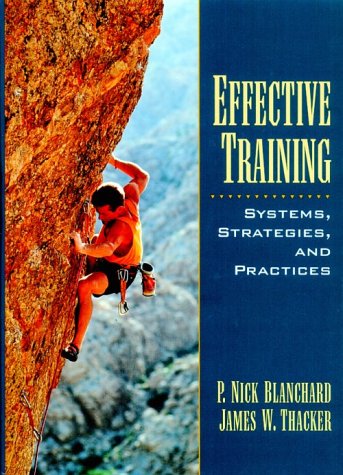
Synopsis
Presents a contingency approach to training that takes into account the organization's overall objectives and strategy. A training model that proceeds from the initial needs analysis through the evaluation of a program's effectiveness is explained, and the relationships between training and organizational change is explored. An emphasis is placed on developing internal strategies which support the overall plan. Case examples are provided throughout. Annotation c. by Book News, Inc., Portland, Or.
"synopsis" may belong to another edition of this title.
From the Back Cover
Recognizing the increasing competitive advantage of human resource competencies and renewed focus on organizational training, this practical manual integrates academic and practitioner information in an easy-to-read format, helping readers understand the process of developing human resources, and providing a thorough analysis of training as it relates to organizational objectives and strategies. Placing training activities in the context of organizational strategy, it emphasizes the conceptual and practical value of developing training programs that effectively meet strategic and tactical needs, with practical examples provided for both large and small organizations. Comprehensive topical coverage includes Strategic Planning, Training and OD; Learning, Motivation and Performance; Training Design; Management Development, and much more. For directors or managers of training or human resource development, new trainers, and consultants.
"About this title" may belong to another edition of this title.
Other Popular Editions of the Same Title
Search results for Effective Training: Systems, Strategies and Practices
Effective Training : Systems, Strategies and Practices
Seller: Better World Books, Mishawaka, IN, U.S.A.
Condition: Good. 1st. Used book that is in clean, average condition without any missing pages. Seller Inventory # 3116599-6
Effective Training: Systems, Strategies and Practices
Seller: ThriftBooks-Atlanta, AUSTELL, GA, U.S.A.
Hardcover. Condition: As New. No Jacket. Pages are clean and are not marred by notes or folds of any kind. ~ ThriftBooks: Read More, Spend Less. Seller Inventory # G0132681609I2N00
Effective Training: Systems, Strategies and Practices
Seller: Copper News Book Store, Ajo, AZ, U.S.A.
Hardcover. Condition: Very Good. 1st Edition. Seller Inventory # 014773
Effective Training: Systems, Strategies and Practices
Seller: WorldofBooks, Goring-By-Sea, WS, United Kingdom
Hardback. Condition: Very Good. The book has been read, but is in excellent condition. Pages are intact and not marred by notes or highlighting. The spine remains undamaged. Seller Inventory # GOR002237415
Buy Used
Quantity: 1 available
Effective Training: Systems, Strategies and Practices
Seller: The Book Spot, Sioux Falls, MN, U.S.A.
Hardcover. Condition: New. Seller Inventory # Abebooks38187

